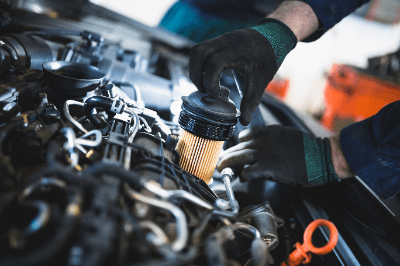What Is an Oil Filter?
 An Oil Filter is a filter that removes sludge, wear particles, and debris from engine oil, hydraulic oil, and other oils.
An Oil Filter is a filter that removes sludge, wear particles, and debris from engine oil, hydraulic oil, and other oils.
For automobiles, it is sometimes called an oil element, and is often used in automobiles and industrial machinery.
Oil gradually oxidizes and becomes dirty as the machine operates. Continued use of dirty oil can lead to machine breakdowns, so the oil must be filtered through an oil Filter.
As filtration causes dirt to accumulate in the filter, periodic replacement is necessary.
Uses of Oil Filters
Oil Filters are widely used in various types of engines and other industrial machinery. Specifically, they are used in automobile engines, automatic transmissions, marine engines, generator engines, and gas turbines.
It is also used in vacuum pumps, agricultural machinery such as mowers and sprayers, hydraulic equipment operating oil, lubricating oil for various machines, and cutting oil for machine tools.
Oil contamination can be caused by the following three factors:
- Oil that has been in the oil circuit from the beginning
- Oil that enters from the outside
- Oil that is generated during machine operation
The first two can be prevented by the structure of the machine and the way it is handled. However, the third point is mainly caused by oxidation and cannot be prevented. Therefore, it is important to use oil filters to keep the oil clean.
Principle of Oil Filter
In general, oil filters remove contaminants by allowing oil to pass through a porous filter material.
Other filtering methods include adsorption by magnets and centrifugal force by increasing the flow velocity. To remove contaminants, the pores in the filter media must be smaller than the contaminants, or the contaminants must be able to adhere to the filter media walls.
Oil filters can be divided into the following three types:
1. Full-Flow Type
The Full-Flow type is used to filter all oil. A bypass valve is generally built in, and this type is widely used in passenger car engines today.
2. Full Flow + Bypass Type
Oil is filtered by dividing the oil flow path into two separate paths, one with a full-flow filter and the other with a bypass filter. The bypass filter can remove smaller contaminants than normal. This type of filter is mainly used in diesel engines.
3. Combination Type
This type combines a full-flow filter and a bypass filter into one. Oil flowing in the flow path is divided into these two filters. This type is used for large diesel engines.
Types of Oil Filters
There are three main types of oil filters:
1. Screen Type Oil Filter
A very fine metal mesh is attached to the oil inlet in the oil pan for filtration. Most engines today use both a filter paper type oil filter and a screen type filter.
2. Built-in Oil Filter
An oil filter made of filter paper is built into the engine or oil pan near the oil strainer. This type of filter is used in motorcycles of relatively old design. In addition, automatic transmissions and continuously variable transmissions for automobiles have a replaceable ATF filter built into the strainer.
3. Cartridge Type and Spin-on Type
The cartridge type installs a removable cartridge outside the engine. The cartridge is reused many times, and only the filter inside is replaced periodically. Compared to the built-in type, the cartridge type requires no opening of the oil pan or other parts of the engine, thus improving serviceability.
The spin-on type, which appeared in the 1950s, has a filter paper oil filter and various valves all built into the casing. It is installed by rotating it directly over the oil passageway on the engine side, and the filter media is discarded with the casing each time the oil filter is replaced. This type of oil filter is used in most automobiles today because it makes replacement work more efficient.
Other Information on Oil Filters
Oil Filter Replacement
When dirt accumulates in the oil filter, the filter becomes clogged and the amount of oil circulating through it is reduced. In this case, the bypass valve opens and the oil barely circulates, but the oil that passes through the bypass valve is not filtered by the oil filter, which causes the filter to deteriorate.
Periodic replacement of the oil and oil filter is necessary because the oil degradation and clogging of the oil filter will cause damage to the equipment. Replacement times are clearly indicated in the manufacturer’s instruction manual.
In the case of automobile engines, engine oil and oil filters must be replaced properly because the use of dirty engine oil can cause engine damage, reduced fuel efficiency, and loss of power. Many manufacturers clearly state when to change the oil and recommend changing the oil filter every two oil changes.